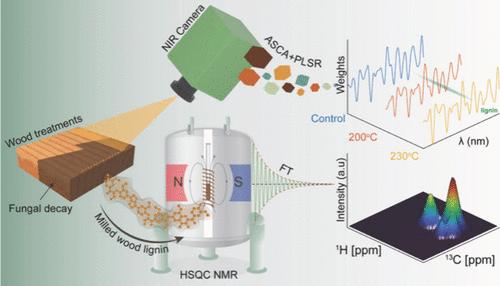Cell Wall Polymer Degradation during Rhodonia placenta Brown Rot Decay of Thermally Modified and Unmodified Wood
IF 7.3
1区 化学
Q1 CHEMISTRY, MULTIDISCIPLINARY
引用次数: 0
Abstract
Thermal modification produces decay-resistant wood suitable for sustainable applications. Although thermally modified wood remains degradable by fungi, its degradation mechanisms are poorly understood, impacting long-term eco-friendly use. This study investigated thermally modified wood degradation by elucidating chemical changes to wood cell wall polymers during Rhodonia placenta brown rot decay. Modified and unmodified Scots pine samples were exposed to R. placenta in stacked-sample decay tests, generating decay stage progressions. Decayed samples were analyzed by near-infrared spectroscopy with multivariate analysis to identify key chemical changes. Milled wood lignin was isolated and analyzed by two-dimensional nuclear magnetic resonance spectroscopy for further lignin chemistry insight. Results showed that R. placenta degraded thermally modified wood to high mass losses. Chemical changes were characterized by carbohydrate degradation and oxidative lignin modification, typical for brown rot. While most degradative changes were similar between modified and unmodified wood, differences in lignin modification patterns were observed. Interestingly, spectroscopic data revealed different chemical changes in the early and late decay stages in modified and unmodified wood. These findings highlight the time-dependent nature of R. placenta degradation and show that thermally modified and unmodified woods are degraded by similar yet different mechanisms, providing new insight into brown rot wood degradation.

热改性和未改性木材胎盘Rhodonia褐腐腐烂过程中细胞壁聚合物的降解
热改性生产出适合可持续应用的耐腐木材。尽管热改性木材仍可被真菌降解,但其降解机制尚不清楚,影响了长期的生态友好使用。本研究通过分析胎盘罗多尼亚褐腐腐烂过程中木材细胞壁聚合物的化学变化来研究热改性木材的降解。改良和未改良的苏格兰松样品暴露在叠样胎盘中进行衰变试验,产生衰变阶段进展。通过近红外光谱分析和多变量分析来确定腐烂样品的关键化学变化。利用二维核磁共振波谱技术对木质素进行分离和分析,进一步深入了解木质素的化学性质。结果表明:羊胎草对热改性木材的质量损失较大;化学变化以碳水化合物降解和氧化木质素修饰为特征,这是褐腐病的典型特征。虽然改性木材和未改性木材的大多数降解变化相似,但木质素修饰模式存在差异。有趣的是,光谱数据揭示了改性和未改性木材在早期和晚期衰变阶段的不同化学变化。这些发现突出了褐腐木降解的时间依赖性,并表明热改性和未改性木材的降解机制相似但不同,为褐腐木的降解提供了新的认识。
本文章由计算机程序翻译,如有差异,请以英文原文为准。
求助全文
约1分钟内获得全文
求助全文
来源期刊

ACS Sustainable Chemistry & Engineering
CHEMISTRY, MULTIDISCIPLINARY-ENGINEERING, CHEMICAL
CiteScore
13.80
自引率
4.80%
发文量
1470
审稿时长
1.7 months
期刊介绍:
ACS Sustainable Chemistry & Engineering is a prestigious weekly peer-reviewed scientific journal published by the American Chemical Society. Dedicated to advancing the principles of green chemistry and green engineering, it covers a wide array of research topics including green chemistry, green engineering, biomass, alternative energy, and life cycle assessment.
The journal welcomes submissions in various formats, including Letters, Articles, Features, and Perspectives (Reviews), that address the challenges of sustainability in the chemical enterprise and contribute to the advancement of sustainable practices. Join us in shaping the future of sustainable chemistry and engineering.
 求助内容:
求助内容: 应助结果提醒方式:
应助结果提醒方式:


